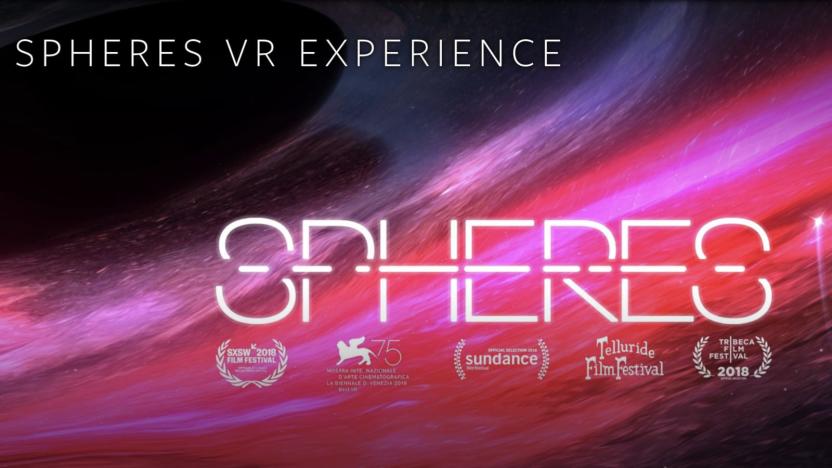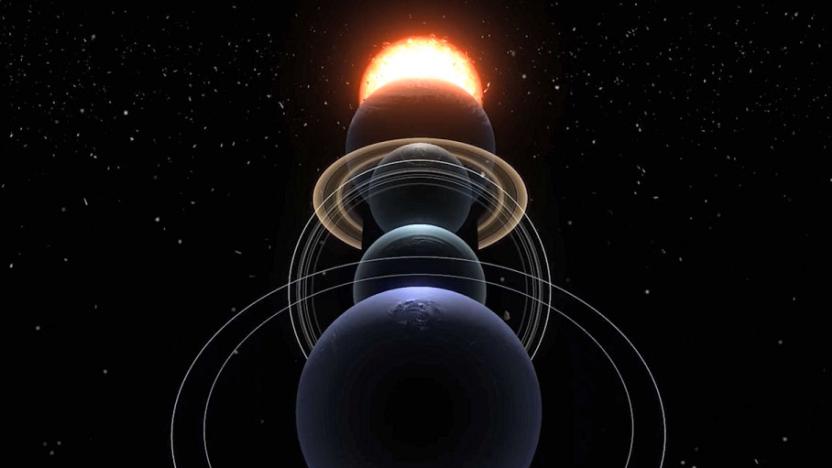spheres
Latest

Aronofsky's VR series 'Spheres' opens to the public in NYC
The Darren Aronofsky-backed space-themed virtual reality series Spheres will finally be available for public viewing starting on January 18th. It'll debut as a VR experience viewed through Oculus Rift headsets at the Rockefeller Center in NYC, with screenings held every day until March 3rd. Spheres consists of three 15-minute chapters, which were originally shown at different film festivals throughout 2018.

Aronofsky's VR project 'Spheres' will premiere at Venice Film Festival
Darren Aronofsky's three-part virtual reality series Spheres -- bought for a seven-figure sum at Sundance earlier this year -- will make its world premiere at the upcoming Venice Film Festival. Adding to its sci-fi credentials is the announcement that Millie Bobby Brown, aka Eleven from Netflix series Stranger Things, will be lending her voice to the final instalment of the trilogy, Spheres: Chorus of the Cosmos.

Darren Aronofsky-backed VR series 'Spheres' lands a 7-figure deal
If you want evidence that VR is maturing as an entertainment medium, you just got it. CityLights just bought the rights to Spheres, the three-part VR black hole series written by Eliza McNitt and produced by Darren Aronofsky's Protozoa Pictures, for a "seven-figure" amount at the Sundance Film Festival. That might not sound like much by Hollywood standards, but it's the first-ever seven-figure VR purchase at the event. It was slated to reach the Oculus Rift in 2018 (Oculus and Intel backed the project) and should get wider distribution as a result.

Oculus shows how much VR has evolved at Sundance
Two years into the rise of modern virtual reality, following the launch of the Oculus Rift, HTC Vive and PlayStation VR, the medium might seem as if it's losing a bit of its luster. Headsets are cheaper and easier to use, especially with new Windows Mixed Reality devices, yet VR experiences are still a mixed bag. That's understandable, since we're stepping into an entirely new art form, but consumer adoption depends on VR creators figuring out their storytelling language soon. Luckily, that seems to be a trend at the Sundance New Frontier Exhibition this year. We're moving beyond the initial "wow factor" and toward more mature experiences that take advantage of VR's unique ability to immerse you.

Daily App: Spheres for iOS is a new way to share photos with family and friends
Spheres is a clever take on photo sharing from iOS devices. Open the app and take a picture, or load one from your camera roll. The picture goes to the cloud, and people that you assign to a group -- called a 'Sphere' -- will receive the photos without having to do anything if they are also running the app. Other individuals can be contacted via email or text message, and they receive a link to view the photos in a browser. Photos can also be shared with social networks including Facebook and Twitter. Spheres has some similarities with Apple's iCloud Photo Sharing service. Apple doesn't use a special app, but shared photos alert anyone you wish to notify, and viewers can comment on or 'like' your photos. Apple also allows others to post photos or videos to your stream from any iOS device, Mac or PC. The Apple service creates web pages for universal sharing and also integrates nicely with Apple TV for viewing streams on large screen displays. Spheres is more automatic. Snap some photos using the camera app built into Spheres, and everyone in your Sphere is notified and receives the new images. A message with a link also is sent so people in the Sphere can view photos on the Web from any device without the app. The app does not currently support iOS notifications, but that feature is coming soon. No account is needed to view images, but Sphere accounts are required for adding pictures. The accounts are free, and you can create a login or use your Facebook credentials. Comparing Spheres to Apple's iCloud offerings, Spheres developer Adam Peterson says "We are trying to create an easier way to privately share Spheres with users in the same geolocation. Anyone can add photos to the Sphere as long as they are invited by the creator." He provides this example of how it can be used. "For example, I create a sphere for my Son's 7th birthday party and we invite all his friends from his class. I know his friends parents are going to be taking a lot of photos at that event and I'm not necessarily close enough friends with them to have phone number or email. This is a way for all attendees at this event to share photos privately with all attendees. This is similar to paying a professional photographer to take photos of the kids at the event but it is free and everyone that is at the event gets all photos instantly." The app is easy to use and works as expected. The only risk is if the developer drops support for the app, because the photos you take with the app are not saved to your camera roll but to Spheres' servers (there is an option to manually save to your camera roll). Spheres maintains its own servers, and has no limits on the amount of photo postings. I think the longevity of your photos would be assured if the app saved your photos to the camera roll automatically. Spheres has a privacy policy similar to many other photo-sharing apps. Your pictures remain your property and can't be exploited by third parties, but the company reserves the right to delete offensive materials if there is a complaint. Spheres is not a universal app. It requires iOS 6.0 or later, and it is optimized for the iPhone 5.

Watch Google test its 3D-sensing phones on robots in zero gravity
Wonder what Google's Project Tango-equipped SPHERES robots will look like when they're in action aboard the International Space Station? The company is more than happy to show you. It has posted video of a recent test that took the machines on a zero gravity simulation flight to see how the 3D environment sensors and other systems will work in practice. As you'll see in the clip, it wasn't quite as easy as testing on the ground -- Google's ATAP team had to work during brief bursts of weightlessness that could challenge both the employees and the devices.

Google's 3D-sensing phones are taking a trip to the International Space Station
It's arguably cool enough that Google is working on smartphones that can scan your surroundings, but now those devices are slated to take a spin in space too. How's that for living in the future? NASA first started sticking smartphones to machines back in 2011 when it used Samsung's Nexus S as the brains for a trio of robotic SPHERES satellite that use bursts of carbon dioxide to putter around the International Space Station. Those aging handsets will soon get the boot, as two of Google's Project Tango smartphones will hitch a ride on Orbital's Cygnus spacecraft when it resupplies the ISS in May. Why? The space agency is interested in seeing if the phone's spatial sensing abilities can help those floating robots navigate their surroundings better than they can right now. If it's lucky, NASA's zeal to upgrade the SPHERES' brains could ultimately lead to the development of a roaming robot that works as well outside the station (or around an asteroid) as it does inside a tin can hurtling around the earth.

Nexus S takes to space aboard Atlantis, does astronauts' dirty work
The last time Google's jet-setting smartphone took to space, it wasn't exactly flying in style. Well, the Nexus S has ditched its styrofoam trappings for more respectable digs -- specifically, NASA's last manned space shuttle, Atlantis. Its mission: "explore how robots can help humans experiment and live in space more efficiently." Affixed to a series of three robotic satellites, known as SPHERES (Synchronized Position Hold, Engage, Reorient, Experimental Satellites) the phones engaged in tasks usually done by their human travel companions, like recording sensor data and capturing video. A special sensor-logging app was customized by NASA to capture sensor data and is now available for download in the Android Market. To see the space traveling smartphone at work, hop on past the break, or hit up NASA's project page at the coverage link below.





